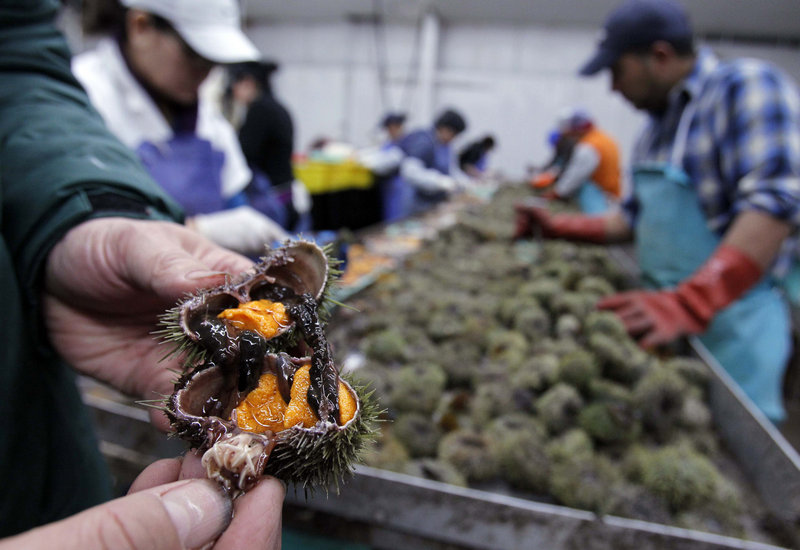PORTLAND — During the heyday, Maine urchin fishermen harvested more than 40 million pounds of the spiny creatures a year. A move is now under way to jumpstart the industry, which has fallen on hard times and is just a skeleton of its former self.
A panel made up of scientists, urchin harvesters and regulators has begun discussions on developing a fishery management plan that would look at how best to maximize the value of the fishery while also protecting the resource.
Nobody expects the industry to return to the days of the 1990s, when it employed thousands of people who harvested and processed the pincushion-looking animals, selling the golden roe to Japan, where it’s a delicacy.
But developing a plan with goals, scientific criteria and a broad regulatory regime could result in a bigger fishery with more jobs, while protecting the urchin population down the road, said Larry Harris, a marine scientist at the University of New Hampshire who is chairman of a panel spearheading the plan. He’d like to see a plan developed by the end of spring and have it go into effect by fall.
“One would love to see greater production, but at the same time it’s important how you do that so it’s sustainable,” Harris said.
Sea urchins used to be a pest in Maine’s coastal waters, where the population multiplied during the 1970s and ’80s, destroying kelp beds and clogging lobster traps.
But that all changed in the late 1980s when processors developed markets in Japan for the urchin roe, or uni. With a gold rush mentality, thousands of fishermen harvested the globular urchins from the ocean bottom by hand or by scooping them up in devices dragged behind their boats. Hundreds more people worked at processing plants along the Portland waterfront.
During the peak years in the mid-1990s, the harvest topped 30 million pounds per year for three years straight, with a peak of 42 million pounds. The value of the fishery exceeded $30 million, making it the No. 2 fishery in the state behind lobster.
But as the urchin population dwindled under heavy pressure, the catch fell sharply. In 2010, the harvest was just 2.6 million pounds, the smallest yield since 1987.
Earlier this year, a Department of Marine Resources advisory board known as the sea urchin zone council began exploring how best to develop a fishery management plan for urchins. A 90-page top-to-bottom review of the department recommended that it be restructured around a policy requiring “sustainable resource management based on management plans with clear objectives and goals.”
The urchin fishery now has two zones, east and west, a limit on the number of harvesters, and size limits on the minimum and maximum size that can be harvested. Urchin divers and draggers in western waters are limited to 10 days a year, while those in eastern waters can go out 45 days a year.
Those regulations are management tools but don’t represent a management plan, said Trish De Graaf, a resource management coordinator for the Department of Marine Resources. A fishery management plan could also include things such as environmental, economic, social and scientific assessments, a look at the history of the fishery and an analysis of the impact of regulatory changes.
A model used by the department suggests the fishery could grow without threatening the long-term health of the urchin population.
“Our model says the fishery would be sustainable if it was a third of what it was back in the 1990s,” De Graaf said. “We don’t have to rebuild to the abnormally large population we had back then, but we’d like to get it to the point where fishermen could make a good livelihoods off it.”
At the peak, a lot of people got into the fishery to make a fast buck before moving on. Those that remain are in it for the long haul, said Joe Leask, a longtime urchin diver from Bath.
The industry is at a crossroads and a fishery management plan is one step in ensuring its longterm viability, he said.
“I’d like to see it be a big industry,” Leask said. “The only limitation on how big it can be is Japan and how much roe it wants. I’d like to see it grow, and to make it grow I think these steps need to be taken now.”
The owner of the state’s largest urchin processing company said the urchin population has been showing signs of improvement, due primarily to the minimum size requirement that forces divers to leave baby urchins on the ocean bottom. The size of the harvest now, though, is as much a function of the marketplace as it is the size of the urchin resource, said Atchan Tamaki, owner of ISF trading in Portland.
“The market is quite a bit downsized in Japan because of the bad economy and the tsunami,” Tamaki said. “The amount of the harvest right now is matching the demand.”
Send questions/comments to the editors.



Success. Please wait for the page to reload. If the page does not reload within 5 seconds, please refresh the page.
Enter your email and password to access comments.
Hi, to comment on stories you must . This profile is in addition to your subscription and website login.
Already have a commenting profile? .
Invalid username/password.
Please check your email to confirm and complete your registration.
Only subscribers are eligible to post comments. Please subscribe or login first for digital access. Here’s why.
Use the form below to reset your password. When you've submitted your account email, we will send an email with a reset code.